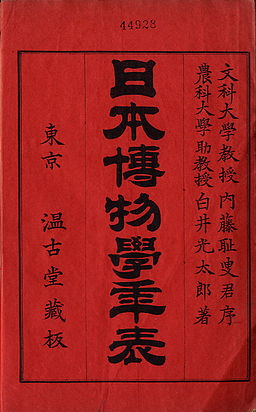Mitsutaro Shirai opens the world's first plant pathology course! Inherit what monja
新しい元号「令和」が始まりました。
新鮮ですね。
「明治生まれで、5つの元号を経験している」というご長寿の方が話題になることもあります。
これからご紹介する白井光太郎は、6つの元号を生き抜いています。
文久、元治、慶応、明治、大正、昭和。
もうすでにご存じの方も、ぜひお付き合いくださいませ。
シライミツタロウとは?植物病理学者
What is Shirai Mitsutaro? Plant pathologist
白井光太郎「しらいみつたろう」植物病理学者です。
史跡名勝天然記念物を、植え継ぎ保存で大活躍。
植物を科学する「植物病理学」の、日本における創始者的な存在。まさに第一人者です。
世界で初めて、大学で植物病理学講座を開設しました。
植物に感染する病原菌の分類を行っています。
植物病理学者で、本草学者であり、のちほど触れますが考古学にも足跡のある博士です。
【国立国会図書館 蔵書印 白井光太郎】

福井藩士の子として生まれ江戸に学ぶ
Born as a child of the Fukui domain and learned from Edo
1863年、時はまさに幕末。
福井藩士の子として江戸で生まれます。
福井藩主・松平春嶽から学問を教わったという逸話も残されています。
松平春嶽といえば、「幕末四賢候」のひとり。明治という元号の命名者。
そして、植物の世界では「日本に西洋リンゴを初めて導入した」ことで知られています。
松平春嶽は、1862年、アメリカのリンゴの苗木を福井藩下屋敷に植えました。
1862年は、政事総裁職に就任する年です。
大政奉還へと向かう時の流れの中ですね。
そんな松平春嶽から、白井光太郎は学問を学び始めます。
白井光太郎だけでなく、多くの若者や子供たちが、機会あるごとに学問を学んでいったそうです。
白井光太郎が学問に触れたときは、すでに文明開化の幕が開けた時代になっていたことでしょう。
まさに激動の時代ですね。
ドイツに留学
Study abroad in Germany
さらにドイツに留学し、植物病理学の研究に触れます。
ドイツへは、日本で作成していた植物寄生菌の写生図を持参しました。
ドイツ・ヨーロッパで研究済みの菌種と比較しています。
その結果、新種の記載が行われ、国際的に研究が大きく前進します。
白井光太郎による新種もしくは新変種は、50種類以上に及びました。
ドイツから帰国後、世界初!
The world's first after returning from Germany!
大学に植物病理学講座が開設されるのは、世界初でした。
もちろん、白井光太郎が教授となります。
考古学にキラリと光るセンスを発揮する
Demonstrate a brilliant sense in archeology
考古学の分野でも、実は大きな足跡を残しています。
現在では定着している「縄文」という表現は、白井光太郎によるものだからです。
モースが発見した大森貝塚には、土器もありました。
「貝塚土器」と呼ばれ、その名称が定着しつつあったのですが。
モースによる表記「cord marked pottery」を、
白井光太郎は「縄紋」という日本語で表現したのです。
「縄紋」は、やがて「縄文」となり、縄文時代という呼び名に使われていきます。
ちなみに、弥生時代・弥生土器の「弥生」という名前は、地名が由来です。
貝塚が発見された東京都文京区弥生の地名です。
「縄紋」という名前は、地名ではなくデザインが由来。
土器の紋様を的確にとらえています。
時代の雰囲気まで象徴するネーミングになりました。
「縄文」という言葉に、白井光太郎博士のセンスがキラリと輝いていると思います。
生態系を大切にする姿勢
Attitude to value the ecosystem
なんじゃもんじゃ!植え継ぎに成功
What the hell! Successful replanting
現在も、2代目・なんじゃもんじゃの木が神宮外苑に新緑を輝かせています。
なんじゃもんじゃ?ってなに
What is it? What
神宮外苑の各所に植えられているヒトツバタゴ(なんじゃもんじゃ)の木に、今年も白いお花が咲いています!満開になると、まるで真っ白な雪に包まれたように見えるヒトツバタゴは、神宮球場の3塁側で見ることができます!満開まではあと少しです。 #神宮球場 #神宮外苑 pic.twitter.com/4kOoUotqA4— 明治神宮野球場(公式) (@jingu_stadiumpr) 2018年4月16日
名前の由来などさまざまですが、共通しているのは、
江戸幕府 将軍と副将軍のエピソード
Episodes of Shogun and Deputy Shogun of the Edo Shogunate
木が植えられている敷地の家の者も、名前を知らないようです。
答えに困りつつも、見事に即答した者がいます。
初代なんじゃもんじゃが植え継ぎされて、現在は2代目です。
日本博物学年表 白井光太郎 著
Japanese Museum Chronology by Mitsutaro Shirai
天然記念物の保存に貢献
Contributes to the preservation of natural monuments
名木が枯れてしまうのは運命でも、接ぎ木の技術で見事に代替わりさせられることを実証していきます。
桜の名所
Cherry blossom spot
おりしも、各地のソメイヨシノが長寿です。
多くの人たちを魅了し続けてきた木々です。
『枯れるから伐る』
『倒れると危ないから倒す』
だからといって、ある日突然に、行政が黙って伐採してしまうのは、痛々しいです。
「別な場所で植え継ぎます」という選択肢もあります。
それならそうと、ひとこと広報されるだけでも、ショックはやわらぐのではと。
まとめ
summary
6つの元号を生き抜いた白井光太郎博士。
植物病理学と接ぎ木の技術。
令和の時代にも活かされ続けて欲しいと願っています。
【2024年5月加筆】 [Updated May 2024]
白井光太郎と植物病理学の発展
白井光太郎(1863-1932)は、日本の植物病理学の先駆者であり、世界初の植物病理学講座を開設したことで知られています。彼の業績は、植物病理学の発展に大きく貢献し、現在もその影響は続いています。2024年5月時点の最新情報を加味し、白井光太郎の業績や植物病理学の発展、そしてヒトツバタゴ(なんじゃもんじゃ)に関する情報を詳しくご紹介します。
白井光太郎の生涯と業績
初期のキャリアと教育
白井光太郎は、1863年に江戸で生まれました。東京帝国大学(現在の東京大学)で植物学を学び、1886年に卒業後、東京農林学校の助教授となりました。その後、1890年に帝国大学農科大学(現在の東京大学農学部)に異動し、植物学講座を担当しました1。
ドイツ留学と植物病理学の研究
1899年から1901年まで、白井はドイツに留学し、植物寄生菌の研究に取り組みました。この留学期間中に、彼は日本でほとんど研究が進んでいなかった植物寄生菌の写生図や標本を多数持参し、ヨーロッパで記載されている種と比較を行いました。この研究により、種の確定や新種記載といった研究の進展に大きく貢献しました1。
世界初の植物病理学講座の開設
1906年、白井は東京帝国大学農科大学に世界初となる植物病理学講座を新設し、これを担当しました。翌年には教授に就任し、植物病理学の教育と研究を推進しました1。彼の研究は、植物に感染する病原菌の分類や記載に焦点を当て、多くの新種や新変種を記載しました。
日本植物病理学会の設立
1920年、白井は日本植物病理学会を設立し、初代会長に就任しました。この学会は、植物病理学の研究と情報交換の場として重要な役割を果たし、現在も活動を続けています1。
ヒトツバタゴ(なんじゃもんじゃ)の保護と研究
ヒトツバタゴの概要
ヒトツバタゴ(Chionanthus retusus)は、モクセイ科の植物で、別名「なんじゃもんじゃ」とも呼ばれます。その純白の花は「雪の花」とも称され、その美しさは多くの人々を魅了しています。日本では、愛知県犬山市や長崎県対馬市などに自生地があり、国の天然記念物に指定されています2。
ヒトツバタゴの保護活動
ヒトツバタゴは、その美しさと希少性から、保護が必要な植物とされています。自生地の保護活動や植樹活動が行われており、未来の世代にもその美しさを伝えるための努力が続けられています。例えば、愛知県犬山市では、自生地の環境保全や観光客のマナー向上を目的とした活動が行われています2。
最新の研究とイベント
2024年には、ヒトツバタゴに関連する様々なイベントが開催されます。以下にいくつかの注目イベントをご紹介します。
犬山市のヒトツバタゴ観賞会
愛知県犬山市では、毎年恒例のヒトツバタゴ観賞会が開催されます。2024年の観賞会は、4月27日から5月14日までの期間に行われ、満開のヒトツバタゴを楽しむことができます。観賞会期間中は、臨時駐車場やトイレが設置され、訪れる人々に快適な環境が提供されます2。
長崎県対馬市のヒトツバタゴ祭り
長崎県対馬市では、ヒトツバタゴ祭りが開催されます。この祭りでは、地元の特産品を販売するブースや、ヒトツバタゴに関する講演会が行われます。2024年の祭りは、5月3日から5月5日までの期間に開催され、多くの観光客が訪れる予定です。
植物病理学の最新動向
デジタル技術の活用
2024年には、植物病理学の分野でもデジタル技術の活用が進んでいます。例えば、ドローンや人工知能(AI)を用いた病害虫の早期発見や、データ解析による予防策の提案が行われています。これにより、農作物の被害を最小限に抑えることが可能となっています3。
国際協力と情報交換
植物病理学の研究は、国際的な協力と情報交換が重要です。2024年には、国際植物病理学会が開催され、最新の研究成果や技術が発表されます。この学会では、世界中の研究者が集まり、植物病理学の発展に向けた議論が行われます3。
まとめ
白井光太郎は、日本の植物病理学の先駆者として、世界初の植物病理学講座を開設し、多くの新種や新変種を記載するなど、植物病理学の発展に大きく貢献しました。彼の業績は現在も続いており、植物病理学の分野での研究や保護活動が進められています。また、ヒトツバタゴ(なんじゃもんじゃ)の保護活動や関連イベントも行われており、その美しさを未来の世代に伝えるための努力が続けられています。ぜひ、これらの情報を参考にして、植物病理学やヒトツバタゴの魅力を堪能してください。



「平成生まれと仕事するんだ」と思ってから何年か経ちましたが、20年すると「令和生まれと仕事するんだ」と思うんでしょうね。
返信削除このコメントは投稿者によって削除されました。
削除生涯現役で仕事すると、子ども・孫・ひ孫世代と一緒に~という流れですね。令和生まれと話が合うといいなあ。
返信削除